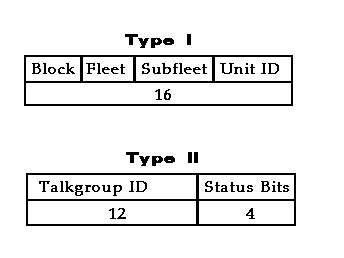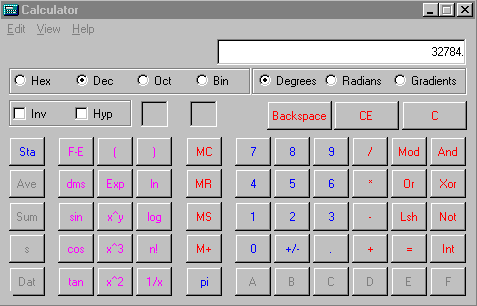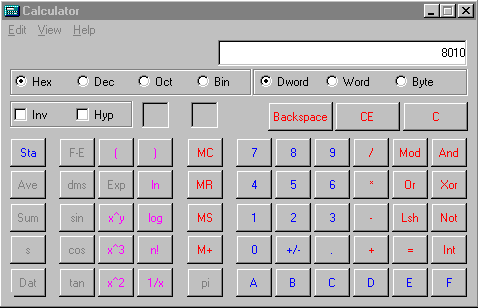With all of the various trunk-tracking scanners and software out there it is sometimes difficult to make sense of talkgroup numbers and understand why they occasionally change during a conversation. This month we'll take a look at Motorola Type II talkgroups and the different ways they can be displayed. We'll also report on a new radio system being built by Motorola for the state of Illinois.
Type II Talkgroups
Since your site seems to be becoming something of a collection point for tiny bits of the trunked jigsaw, if you are interested, the codes showing up on my 780 for Palm Springs Police Department in California are:
32784 - main channel
32816 - secondary
32912 - surveillanceThere are batches of other things ranging from the Airport to the dogcatcher but I haven't logged them down. The reason I note the above numbers is that they are distinctly different from those shown in the Uniden/Bearcat booklet which are in the format 200-13, 400-04, etc.
Regards, David
David, congratulations on your purchase of a Uniden 780XLT scanner. Although the manual for the scanner is pretty good, there is often confusion about the way a talkgroup may be displayed.
The City of Palm Springs, California, is listed as having a Motorola hybrid system, which means it carries both Type I and Type II traffic. Apparently the Police Department uses Type II radios and the other city services use Type I. Five frequencies are licensed to the city, namely 857.4875, 858.4875, 858.9625, 859.4875 and 860.7125 MHz.
Type I and Type II transmissions both use sixteen binary digits, or bits, to represent a talkgroup. These bits are sent out with every repeater transmission and are interpreted by your scanner.

A Type I system divides up those 16 bits into blocks, fleets, subfleets, and users. Talkgroups in Type I systems are usually displayed as FFF-SS, where FFF is a Fleet ID and SS is a subfleet ID. The trick with Type I systems is determining exactly how a particular system divides up those 16 bits. That information is represented by a fleet map, which I described in detail in the August 2000 Tracking the Trunks column. Back issues of Monitoring Times are $4.50 from Grove Enterprises 800-438-8155 and previous Tracking the Trunks columns are on my website at www.signalharbor.com.
Status Bits
A Type II system divides the 16 bits differently than a Type I system. The 16 bits in a Type II system are split into 12 bits of talkgroup identifier and 4 status bits. The status bits identify special situations and are usually all zeroes.
| Right-most Status Bits |
Decimal | Meaning |
| 000 | 0 | Normal transmission |
| 001 | 1 | Fleet-wide (A talkgroup for all radios) |
| 010 | 2 | Emergency |
| 011 | 3 | Crosspatch between talkgroups |
| 100 | 4 | Emergency crosspatch |
| 101 | 5 | Emergency multi-select |
| 110 | 6 | Unknown |
| 111 | 7 | Multi-select (initiated by the dispatcher) |
The three right-most status bits indicate if the message is an emergency and whether the talkgroup is interconnected in some way. The left-most status bit indicates whether or not the transmission is encrypted using the Data Encryption Standard (DES). A zero bit means the message is not encrypted and a one bit means it is encrypted. For example, a normal message has status bits of 0000 (0 in decimal). If that transmission was encrypted, it would have status bits of 1000 (8 in decimal). An emergency message that is not encrypted has status bits of 0010 (2 in decimal), while an encrypted emergency message would have status bits of 1010 (10 in decimal). Note that an encrypted message implies that it is in digital format and that it will come out of your scanner as a harsh buzzing sound instead of the radio user's voice.
The complete set of sixteen bits that make up a talkgroup can be displayed a number of ways. They can be shown as a decimal number, like 32784 or 59216. They may also appear as hexadecimal numbers, such as 801 or E75.
The conversion between decimal and hexadecimal is straightforward. The easiest way is to use a scientific calculator, and it just so happens that one comes with Microsoft Windows.
In Windows, Press the Start button, select Programs and then Accessories. Click on the Calculator selection to start the Windows calculator program. Once the calculator program is running, you'll need to switch from Standard to Scientific mode, which you can do by clicking on "View" in the menu bar and choosing "Scientific".
The scientific calculator has quite a few buttons, but we're only interested in the selections in the upper left-hand side just below the display. The program starts out with "Dec" (decimal) option selected, meaning the display will show numbers in the usual decimal format.

In David's example, the main channel has a decimal talkgroup of 32784. So, in the calculator we enter 32784 and then select the "Hex" (hexadecimal) option. The display changes to show 8010. Each hexadecimal digit represents four bits of the talkgroup number, with the last digit representing the status bits. Because the last four bits are zero for a normal talkgroup, many listings drop the last digit of the hexadecimal number. In David's example the talkgroup would be represented in hex as 801.

We can also view the same number in binary by choosing the "Bin" option. 32784 is equivalent to 1000 0000 0001 0000. These are the sixteen bits that make up the Type II talkgroup. The last four bits are all zero, meaning the status bits are indicating this ID is a normal talkgroup.
In fact, the status bits in each of the three talkgroups David mentions are all zero:
| Decimal | Hexadecimal | Binary |
| 32784 | 8010 | 1000 0000 0001 0000 |
| 32816 | 8030 | 1000 0000 0011 0000 |
| 32912 | 8090 | 1000 0000 1001 0000 |
Interesting things happen when the status bits are something other than zero. If, for example, the Palm Beach surveillance talkgroup of 32912 had an emergency message, the status bits would change from 0000 to 0010, so the sixteen bits of the talkgroup then become 1000 0000 1001 0010. If we put this binary number into the calculator and convert it to decimal, we find the new decimal number to be 32914.
Some scanners may be preset to ignore status bits in a Motorola system and always report the same talkgroup no matter what happens. This feature may have to be disabled in order to figure out Type I fleet maps, but is handy for following Type II conversations.
Other scanners will always display the full talkgroup number, which may change during a conversation depending on the status bits. This can cause the scanner to miss conversations if each of the possible talkgroups are not programmed into the scan list.
To sum up for David, the numbers he's reporting are valid Type II talkgroups from the Palm Springs Police Department. The other numbers in the format FFF-SS are talkgroups from the other Type I radios that share the hybrid system.
Illinois Starcom 21
Dan,I read your pages in Monitoring Times January 2001 and decided to drop you a line. I got this information from a local newspaper just last week. Illinois Governor Ryan announced a $25 million grant for a new radio system phased in over the next 3 years. The state will lease time on the new Starcom 21 network from Motorola. It will be made available to other federal, state, and local public safety agencies if they want to update their own outmoded systems.
Reading between the lines, I would say the state police are going to phase out their low band radio system statewide. Also I would assume the Illinois Department of Transportation 47 MHz system will follow also. The VHF 155 MHz state police frequency will have to stay in place for use with other police departments (ISPERN, IREACH etc.) As we already know the state police districts in the Chicago area are already using 800mhz.
I don't know anything about Starcom21-is there a scanner yet that will work with this system? Or is this digital? Maybe a competitive brand two-way radio down the road properly programmed will be around. A the rate everyone is going, no one will be left on lowband. I've always said give 29.7 - 54 MHz to us hams (we like skip conditions) and trade part of the 440 MHz and also 1.2 GHz for commercial use (they don't like skip).
Daryl
Thanks for the information, Daryl. Funding for the Starcom 21 network comes out of the Venture TECH fund from the Illinois Technology Office. This fund promises to provide research and development dollars for a number of law enforcement initiatives, including expansion of the Illinois State Police Wireless Information Network, wireless access to photographic images and fingerprints, more rapid access to wants and warrants databases, and an automated voice dispatch system. The new Starcom 21 network is one of those initiatives.
Motorola, headquartered in the Chicago suburb of Schaumburg, was selected to build Starcom 21after a competitive bid process. The Illinois State Police will purchase new radios and lease airtime on the network, as will other federal, state, and local public safety agencies. Rather than spending a lot of money to establish their own independent systems, county and local agencies will have the option of joining the state network.
The plan is to phase in the network over three years, starting with coverage in the southern part of the state and moving northward. The state hopes that by having one common radio system, problems of interoperability -- the ability of agencies to communicate directly with each other -- will be a thing of the past.
As Daryl noted, the Chicago District of the Illinois State Police is currently using a trunked radio system. It's actually two EDACS networks, one covering a northern patrol area and the other a southern patrol. Frequencies in LCN (Logical Channel Number) order are:
North: 866.8875, 866.4625, 867.3875, 866.9625, 867.4625, 867.8875, 868.3875, 868.4625, 868.8875 and 868.9625 MHz.
South: 866.4125, 866.4375, 866.9375, 867.4125, 867.9375, 867.9125, 868.4375, 868.4125, 868.9375 and 868.9125 MHz.
Unfortunately, I don't have any technical details about the Starcom 21 system. I expect that it will be a trunked digital system, but I don't know if it will be compatible with other Motorola products or with the APCO 25 standards, or something all together new. If readers have any further information about the system, please send it along!
NPSPAC
Starcom 21 will almost certainly have the capability of operating on the National Public Safety Planning Advisory Committee (NPSPAC) 800 MHz frequencies. The NPSPAC was formed more than ten years ago to provide guidance in the use and coordination of public safety radio frequencies, and their recommendations included the establishment of common inter-agency frequencies.
Five channels in the 800 MHz band are set aside for mutual aid across the country. One frequency, 866.0125 MHz, is designated a calling channel. The other four, at 866.5125, 867.0125, 867.5125 and 868.0125 MHz, are tactical channels. Each of these channels is 25 kHz wide and operates conventionally (that is, not trunked) with a tone coded squelch frequency of 156.7.
So, as you're scanning the 800 MHz band, be sure to include these five non-trunked frequencies in one of your scan banks.
That's all for this month. More information is available on my website at www.signalharbor.com, and I welcome your e-mail at dan@signalharbor.com. Until next month, happy monitoring!